
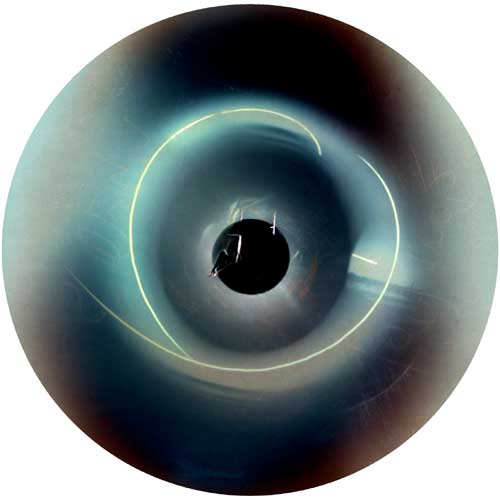
Cyklografia H 08-14.02.2003r
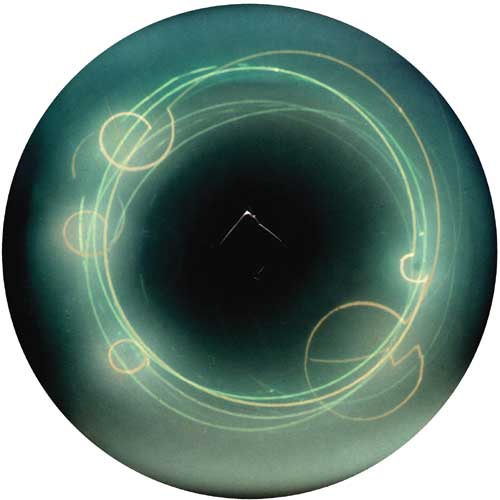
Cyklografia (M), Anomalia, 15-19.01.2003r
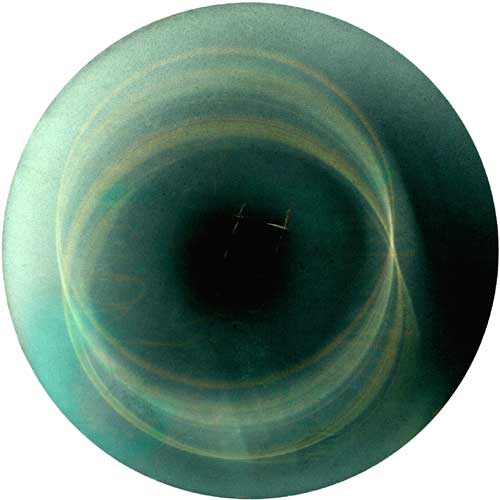
Cyklografia (M), Anomalia, 15-19.01.2003r..tif
Cyclographics are unusual photographs, taken by means of a pin-hole camera.
These photographs are traces of the Sun, registered through a narrow opening in a mechanical disc which moves in regular cycles in a circle. The construction of a camera used to take such pictures is a combination of an optical darkroom and a clockwork mechanism. Inside the camera photographic paper has been placed.
Cameras modified in this way are then mounted in various sunny places while the image that appears on paper is the result of constant exposition that lasts for days.
The disc with the opening is controlled mechanically or manually. The direction of the revolutions which follow the Sun is always opposite to the direction of the Earth's revolutions.
These photographs are traces of the Sun, registered through a narrow opening in a mechanical disc which moves in regular cycles in a circle. The construction of a camera used to take such pictures is a combination of an optical darkroom and a clockwork mechanism. Inside the camera photographic paper has been placed.
Cameras modified in this way are then mounted in various sunny places while the image that appears on paper is the result of constant exposition that lasts for days.
The disc with the opening is controlled mechanically or manually. The direction of the revolutions which follow the Sun is always opposite to the direction of the Earth's revolutions.
Movement cycles
- Yearly disc (Y) - 1 revolution per year
- Monthly disc (Mth) - 1 revolution per month
- Weekly disc (W) - 1 revolution per week
- Daily disc (D) - 1 revolution per day
- Hourly disc (H) - 1 revolution every 12 hours
- Minute disc (M) - 1 revolution every hour
- Second disc (S) - 1 revolution per minute
Sławomir Decyk
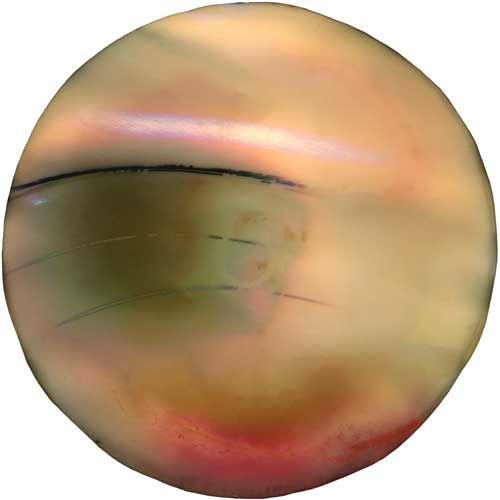
Cyklografia (Mth), 2005.tif
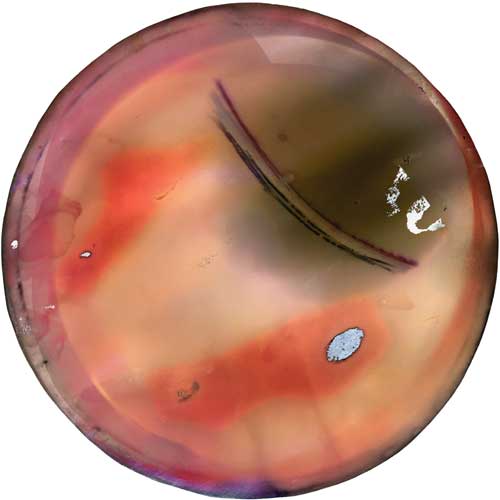
Cyklografia (Y), 2005
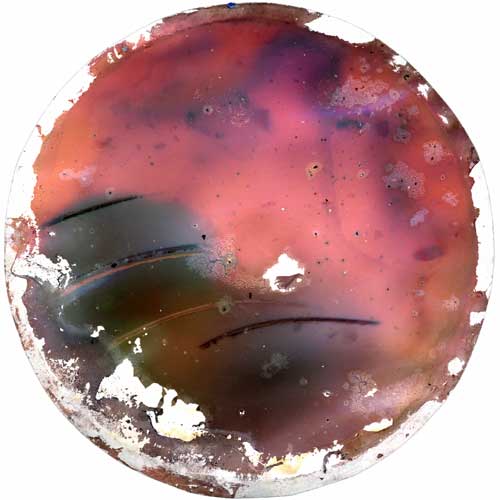
Cyklografia(W), 2005.tif
(Notes on Solarigraphics and Cyclographics)
Sławomir Decyk is an author who persistently asks fundamental questions about fundamental problems and is constantly amazed by the object of his studies. Fundamental, however, does not necessarily mean "obvious". On the contrary. Everything that is most important in the experience that art offers man is based on the revision of the hitherto open possibilities of conducting a dialogue with the world. We always strive for its verification and try to modify such ready-made, traditional forms of this dialogue. It is a basic task. And although it always leads to the experience of something, experience of concrete objects and phenomena, they do not establish the value of art. "Art does not represent what man sees but what he makes visible" - wrote Paul Klee in 1920 and the accuracy of this remark is confirmed by every successful proposition that contains our experience in new categories. The concrete or traces of reality, however one understands those terms, are indispensable in art. They are its obvious aspect which is but a condition of a much more fundamental problem: the problem of making things visible - the problem of revelation.
Such basic questions, however, not only suggest the possibility of revision of old means of experiencing and understanding reality. It is at this point that we can realize that certain problems can never be resolved and - at the same time - we become convinced about how important they are. In relation to the problems in question this method of asking basic questions, formed through the ages, seems the most effective.
Such basic questions, however, not only suggest the possibility of revision of old means of experiencing and understanding reality. It is at this point that we can realize that certain problems can never be resolved and - at the same time - we become convinced about how important they are. In relation to the problems in question this method of asking basic questions, formed through the ages, seems the most effective.
 Solarigraphics are images that register the traces of the movement of the Sun and Sławomir Decyk is one of the artists who invented this unique photographic technique, resulting in the most surprising images. Two other co-authors of this method are Paweł Kula and Diego Lopez Calvin. The images called Solarigraphics come into being in cameras without lenses which also are the authors' own invention. Light-sensisitive material is exposed here in such a way that the image is revealed directly, without the use of further chemical processes. This method allows for extremely long exposition time. The technique is so simple that the images created by its means seem quite incredible. Extremely long expositions, which often last for months on end, show the Sun as a person independent from the power of time could see it, a person who has control over time, who can contract or expand it at will. Solarigraphs belong to this group of images which let us almost tangibly experience the features and limitations of all fundamental categories by means of which we grasp reality. The above-mentioned simplicity and the possibility of mastering it quite quickly even by those who do not know much about the secrets of photographic imagery, allowed the authors to develop their experiences into a project called Solaris. Artistic effects of this project may be found on the Internet. The project was open and the authors invited other artists to take an active part in it. The choice of the Internet as the basic medium of those solaric works was also significant. The quick, mutual exchange of experiences and the observation of the working progress of other participants were the two reasons why we had to do here with authentic group activity, rather rare in the case of such enterprises in which fascination with a new problem dominates. The opportunity of confronting images of the movement of the Sun registered in different parts of the globe was an important element of the project. Such constant registration, sometimes lasting many months, may be compared to the process of monitoring. It is conducted by means of instruments which "observe" the Sun according to specific, pre-established initial conditions. After the cameras have been set, they are left without control for a long time. Sławomir Decyk, like other authors taking part in the project, stressed this particular aspect of registering solar images. In the Solaris project nature observes itself, creating its own image without the burden of the limits of human imagination. And although it is but a utopian assumption which can never be realized, I consider it to be the source of great value of the works that came into being. The authors tackled the problem that has always been interesting for artists. For ages they have been looking for methods and tools that could help them to overcome the limits of their own imagination and allow to look at the world through "non-human" eyes. In the 19th century photography came along and helped them.
Solarigraphics are images that register the traces of the movement of the Sun and Sławomir Decyk is one of the artists who invented this unique photographic technique, resulting in the most surprising images. Two other co-authors of this method are Paweł Kula and Diego Lopez Calvin. The images called Solarigraphics come into being in cameras without lenses which also are the authors' own invention. Light-sensisitive material is exposed here in such a way that the image is revealed directly, without the use of further chemical processes. This method allows for extremely long exposition time. The technique is so simple that the images created by its means seem quite incredible. Extremely long expositions, which often last for months on end, show the Sun as a person independent from the power of time could see it, a person who has control over time, who can contract or expand it at will. Solarigraphs belong to this group of images which let us almost tangibly experience the features and limitations of all fundamental categories by means of which we grasp reality. The above-mentioned simplicity and the possibility of mastering it quite quickly even by those who do not know much about the secrets of photographic imagery, allowed the authors to develop their experiences into a project called Solaris. Artistic effects of this project may be found on the Internet. The project was open and the authors invited other artists to take an active part in it. The choice of the Internet as the basic medium of those solaric works was also significant. The quick, mutual exchange of experiences and the observation of the working progress of other participants were the two reasons why we had to do here with authentic group activity, rather rare in the case of such enterprises in which fascination with a new problem dominates. The opportunity of confronting images of the movement of the Sun registered in different parts of the globe was an important element of the project. Such constant registration, sometimes lasting many months, may be compared to the process of monitoring. It is conducted by means of instruments which "observe" the Sun according to specific, pre-established initial conditions. After the cameras have been set, they are left without control for a long time. Sławomir Decyk, like other authors taking part in the project, stressed this particular aspect of registering solar images. In the Solaris project nature observes itself, creating its own image without the burden of the limits of human imagination. And although it is but a utopian assumption which can never be realized, I consider it to be the source of great value of the works that came into being. The authors tackled the problem that has always been interesting for artists. For ages they have been looking for methods and tools that could help them to overcome the limits of their own imagination and allow to look at the world through "non-human" eyes. In the 19th century photography came along and helped them. 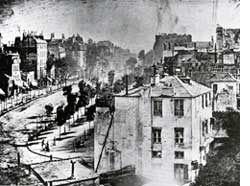 In 1838 Louis-Jacques-Mande Daguerre shows his Boulevard du Temple, one of the most famous pictures in the history of photography. Mechanical method of creating images immediately introduces new rules of the game and imposes its own hierarchy of values. The inhabitants disappear from the crowded boulevard. This deeply transformed image of Paris is especially praised for its credibility and the precision of its representation. What counts is what can be caught by the camera. The rest is pushed away into the margins of our attention. And even those first photographic works reveal the discrepancy characteristic for all future means of mechanical registration of images. Namely, photography confirms the value of our sense of vision and simultaneously questions it emphatically. Therefore, we can formulate a different question about Daguerre's image and ask what it was that escaped mechanical registration.
In 1838 Louis-Jacques-Mande Daguerre shows his Boulevard du Temple, one of the most famous pictures in the history of photography. Mechanical method of creating images immediately introduces new rules of the game and imposes its own hierarchy of values. The inhabitants disappear from the crowded boulevard. This deeply transformed image of Paris is especially praised for its credibility and the precision of its representation. What counts is what can be caught by the camera. The rest is pushed away into the margins of our attention. And even those first photographic works reveal the discrepancy characteristic for all future means of mechanical registration of images. Namely, photography confirms the value of our sense of vision and simultaneously questions it emphatically. Therefore, we can formulate a different question about Daguerre's image and ask what it was that escaped mechanical registration. The photographic project called Solaris radically reverses the hierarchy of values employed in connection with the object of mechanical registration. The most important part of a photographic image is what only a photograph can reveal. Such images are not interested in universal views of things but they still remain photography, a faithful trace of whatever has materialized in front of the camera. In this case photography generates its own ways of noting the presence of reality, just like in the case of Boulevard de Temps it generated its own ways of making it disappear and deleting it. Therefore, the essence of mechanical reflection of reality is found in what is introduced by the tool itself and not in the copy of our visual experience. This experience is "only" an indispensable element that "fills" the picture
In Cyclographics the constant movement of the disc that conditions the registration and the movement of the Sun combine to create a synthetic picture. Both elements significantly influence the form of registration which is not based on motionless observation of the horizon. That is where, in my opinion, the basic difference between the previously discussed Solarigraphics and the Cyclographics series lies. A distinguished and immovable observation point is the most photographic (in the traditional sense of that term) aspect of the project previously discussed. I especially have in mind the possibility of making certain authorial decisions as to the place and time of registration, like in traditional photography, where we cannot exclude more or less conscious, purely aesthetic reasons for making them. This authorial control can be seen in some works created on the basis of the Solaris project.
If we treat photography as a natural phenomenon to a certain extent, then every kind of "domesticated" objectivity of the image becomes an alien element, something that is simply added to the work by way of convention. Such an authorial or aesthetic attitude may then be treated as a kind of inconsistency - as resignation from previous, radical propositions.
The idea of Solarigraphics and later Cyclographics is clearly burdened with the notion of the author which differs from traditional concepts of authorship. I believe that the main reason for this is Decyk's original opinion on the fundamental features of photography. Its descriptive function, responsible for making copies of reality, is less significant, while the image, conceived as the projection of reality or one of its aspects, moves to the foreground. Photography does not double or imitate the images of reality - it is a reality in itself. It is one of the many traces accessible to our experience. How, then, can we ask questions about the author's role in the creative process?
In the process of creating Cyclographics an impersonal character of registration plays an important part. I have already mentioned this problem when discussing the foundations of Solarigraphics and pointing out that the registration process seems to resemble the monitoring of reality. In the works by Decyk presented at the current exhibition this phenomenon is intensified. Cyclographics are products of machines that "imprint" traces of reality in the photographs. We could not really say that by using those machines the author observes or registrates anything - he rather unexpectedly discovers the surprising results achieved by the instruments he has built.
A clock and a photographic camera are technical devices but the features and qualities of their products are completely different in character. The photographic image thanks to a cultural convention is considered to be "somebody's" in the many senses of that term. The time of the clocks is rather "nobody's", as it is shared by all such mechanisms. What is, then, the role of "a clock" that creates images?
Our culture has subdued photography and established the tyranny of perfectly understandable images. Therefore, mechanical and electronic registrations show us only what we want to see. But Sławomir Decyk's proposition goes beyond such use of photography. A French philosopher, Jean Baudrillard, admits that he regrets the aesthetization of photography and the fact that such images have formed one of the branches of fine arts and fallen into the abyss of culture. In his opinion, the photographic image precedes aesthetics or follows it, it is born of the essence of its own technique and that is why it caused such a revolution in representation. It is an untamed phenomenon which cannot be reduced to the aesthetic aspect of things, connected with their external appearance and their illusory obviousness.
Sławomir Decyk's Cyclographics are the result of his fascination with an untamed image and provide the viewer with a valuable experience of whatever is hidden under the surface of all phenomena to which we can become eyewitnesses.
Piotr Wołyński
Translation Maciej Świerkocki
Translation Maciej Świerkocki
Look also: free.art.pl/solaris

Exhibition organized as part of an
OPERATIONAL PROGRAMME
"Art Promotion"
of the Ministry of Culture of the Republic of Poland
Copyright ©2005 Galeria FF ŁDK, Sławomir Decyk, Piotr Wołyński.